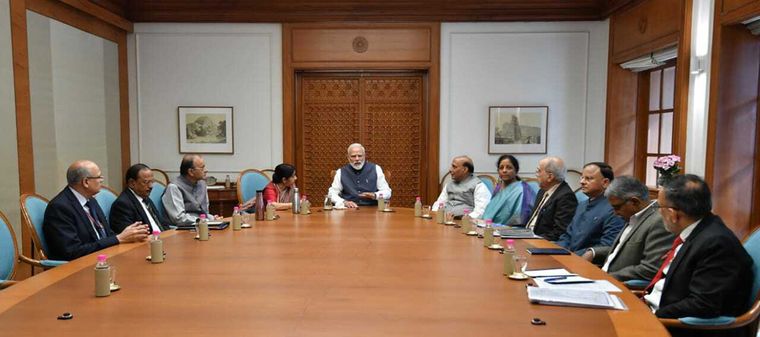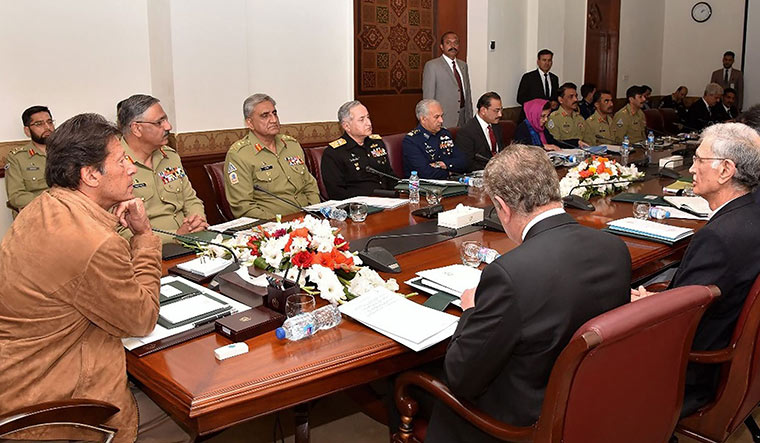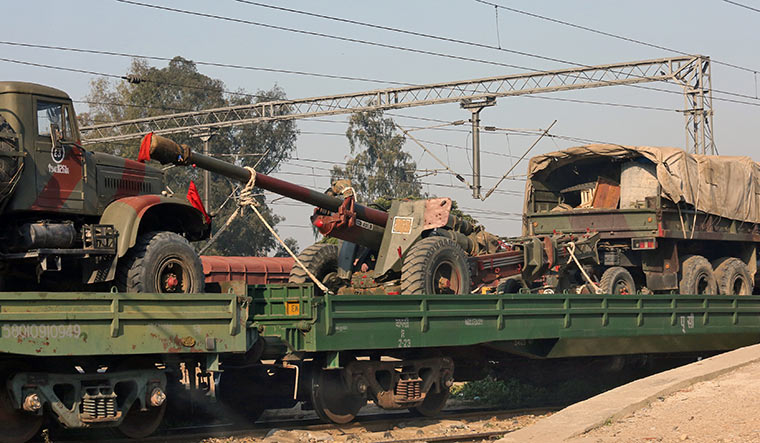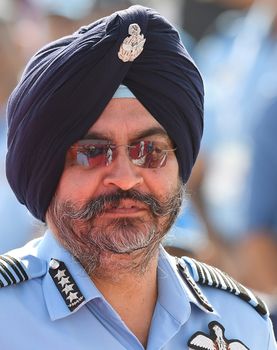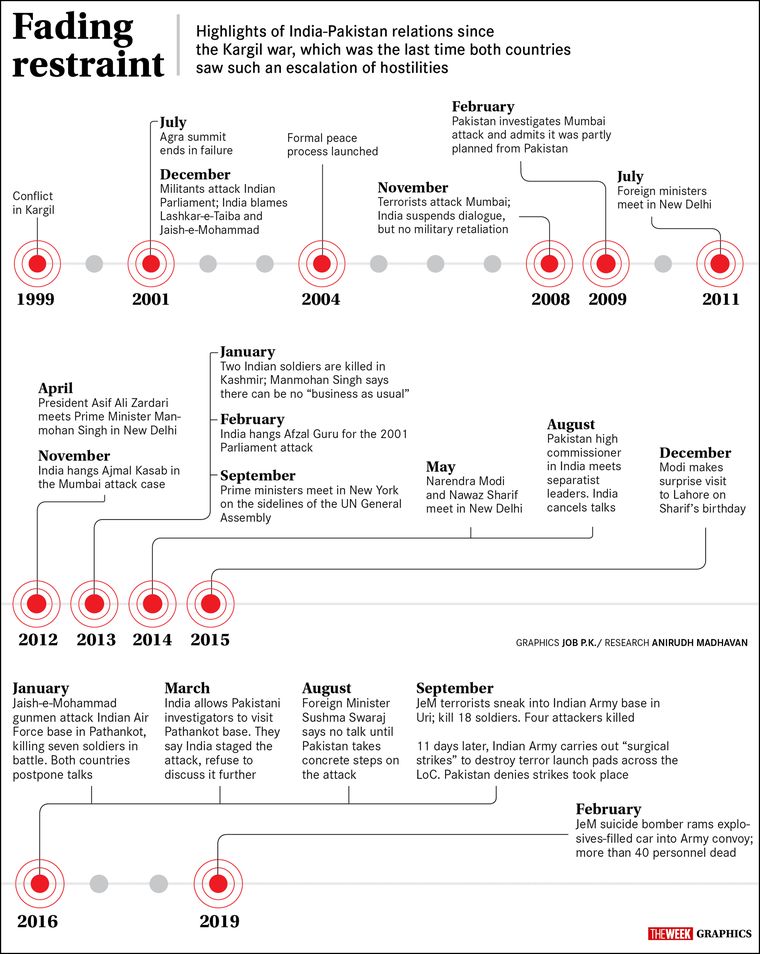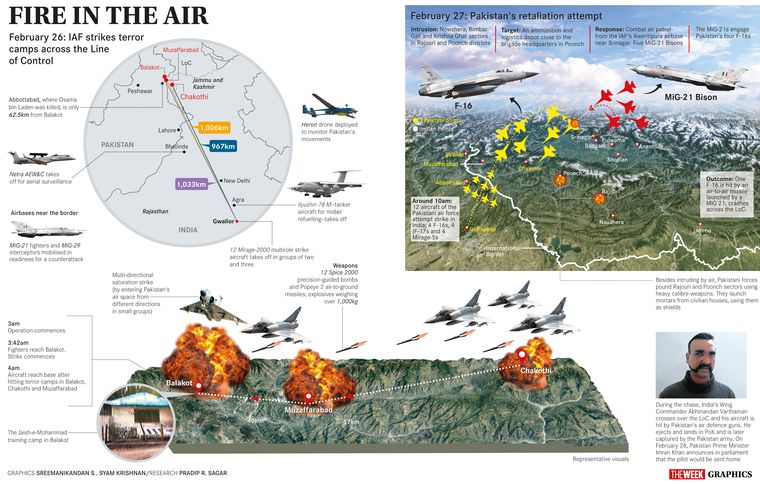It was a coincidence, but a propitious one. Two days after a suicide bomber had driven his explosive-laden Maruti Eeco into a trooper convoy at Pulwama, killing 40 CRPF constables and escorts, the Indian Air Force had its scheduled annual firepower demonstration, Vayu Shakti, on February 16. There, in the Pokhran range where the exercise takes place every spring, several Mirages, MiG-27s and Jaguars emptied their precision bombs and ground-strike munitions in front of hundreds of news cameras, secret recoding devices and even satellite eyes of the big powers. Not more than five men on the grandstand of the VIPs knew that a few of the aircraft were actually rehearsing the strikes that they would deliver in real enemy territory exactly a week later.
A day before the exercise, Air Chief Marshal B.S. Dhanoa had driven up the Raisina Hill from his Vayu Bhawan office and given a presentation to Prime Minister Narendra Modi, National Security Adviser Ajit Doval and some of their closest security aides. There he had reiterated what several other chiefs before him had told their prime ministers—that the IAF had the capability to deliver precision strikes on terror camps in Pakistan as also occupied Kashmir.
But there was a difference this time. On earlier occasions when air strikes had been thought of, the targets had been close to the Line of Control, mostly in occupied Kashmir. This time, however, an overcautious Pakistan had emptied out all the terror training camps and launchpads near the LoC, and moved them into the sovereign territory of Pakistan. Hitting those could provoke the enemy into retaliating in kind, Dhanoa is said to have warned. Would the political leadership be willing to risk an escalation?
It was that risk that had held back several governments earlier from hitting the truant neighbour with military force—after the attack on Parliament, after the attack in Mumbai, after the attacks in Pathankot, Uri and several other places. But this time, the mood had changed.
All the same, as the chief was about to leave, the prime minister is said to have added a clause of caution—strike at the terror camp, but ensure that there will be no collateral damage on any military installation or civilian life and property.
As the senior air staff at Vayu Bhawan scrambled to assess the situation, they found that it would be no easy task. For Pakistan is a country dotted with military installations, and most terror training camps were close to, or even attached to military stations. The strikes would have to be pin-precise.
Meanwhile, the chiefs and their staff officers had received inputs from the R&AW and IB, whose heads Anil Dhasmana and Rajiv Jain were also present at the meeting. One target that would yield politico-military dividend was the Bahawalpur headquarters of Masood Azhar, the head of the Jaish-e-Mohammad that had perpetrated the Pulwama and several other attacks on India.
But Bahawalpur was soon ruled out for several reasons, the foremost being that it was well-guarded by the Pakistani army and air defence. Moreover, the clutter of talk from India about Bahawalpur had made Pakistan virtually “over-guard” their precious asset. Meanwhile, the National Technical Research Organisation had supplied satellite pictures and data about 30 terror-training locations, including the ones at Jalalabad, Balakot, Khalid bin Wahid, Jungal Mangal, Abbottabad and Tarbela, all of which were reporting heightened activity, perhaps due to the arrival of the trainers and recruits from the camps in PoK. “Such missions are the result of great coordination among all the agencies,” pointed out Alok Joshi, former NTRO chief who was part of the planning for the 2016 surgical strikes.
The choice was soon made—the strike would be on the Syed Ahmed Shaheed training camp in Balakot, not the Balakot in Poonch near the line of control, but the little town of Balakot in Khyber Pakhtunkhwa on the sovereign territory of Pakistan. The outskirts of the town had hosted one of the oldest terror training camps of Pakistan which, some say, dated back to the days when President Zia-ul-Haq arranged training for the Afghan mujahideen to wage war against the Soviet military in the 1980s. The facility had since been given over to Hizbul Mujahideen and in recent years to Jaish-e-Mohammad. “There are several such terror camps inside Pakistan and these details have been shared with the Pakistan government time and again,” former home secretary G.K. Pillai told THE WEEK. “However, no action has been taken to dismantle the terror infrastructure on its soil. Balakot is one such facility that has been used by multiple terror organisations.”
The hilltop facility by the Kunhar river offered a sprawling campus, where recruits were imparted the advanced Daura-e-Khaas training in weapons, explosives and field tactics, tactics for attacking security convoys, planting and making improvised explosive devices, preparations for suicide bombing, rigging vehicles for suicide attacks and survival tactics in high altitude and under extreme stress. Masood had been known to visit the place to give inspirational lectures, and he had entrusted the administration of the camp to his brother-in-law Yusuf Azhar, alias Ustad Ghauri, who is suspected to have masterminded the Pulwama attack. “Balakot was used for battle inoculation,” said the intelligence dossiers presented to the prime minister.
The snoops also had copies of dossiers kept by the Pakistan Punjab government on 42 Jaish-e-Mohammad instructors, all of who had trained, and some of whom were training fresh recruits at Balakot, complete with their phone numbers, names of parents, and home addresses in Bahawalpur, Multan, Rawalpindi, Faisalabad, Attock, Sahiwal, Muzaffarabad, Rajanpur and Mianwali. They also told the prime minister that Masood Azhar himself had been at the Balakot facility on February 5, which was Kashmir Solidarity Day. His earlier visit had been in October when he had offered a prayer for acceptance of the “martyrdom” of his 18-year-old nephew Usman (son of his elder brother Ibrahim Azhar), who had been gunned down by security forces in Tral in Kashmir. Azhar had urged Kashmiris to follow in the footsteps of Usman. Adil Ahmad Dar, the Pulwama fidayeen bomber, is said to have been inspired by that speech, which was circulated on social media. And Yusuf Azhar, who had been trained at Balakot, was training more youngsters there. All this made Balakot the perfect target.
Balakot was finally zeroed in on, but the prime minister still had a word of caution—no collateral damage to civilian or military lives or assets, please.
Thus, it was with the weight of the Balakot mission in mind that Dhanoa flew to Pohkran the next day. When media men quizzed him there, he would only say that the IAF was ever prepared to deliver “appropriate response” as assigned by India’s political leadership. Two days later, on February 18, Dhanoa was again summoned to the prime minister’s office, where he received the final go-ahead. The same evening, Dhanoa’s office called the No 7 squadron in Gwalior, and assigned it the task.
By then, the IAF had done the complete operational planning with Air Marshal Hari Kumar, chief of the Delhi-based Western Command, and Air Marshal Rajesh Kumar, head of the Allahabad-based Central Command. Central Command because the Gwalior squadron came under it, and western command because it would have to provide all the support, such as escorts, air defence cover, early warning and even mid-air refuelling from the huge Ilyushin-78 tankers.
But why Mirages, and that too all the way from Gwalior? Why not the equally advanced MiG-29 from Adampur, dedicated ground attack MiG-27 from Bathinda, deep-strike Jaguars from Ambala or the workhorse MiG-Biz from Pathankot or elsewhere? Several factors went into the selection of the strike aircraft, the route of ingress and even the logistics. “For carrying out such operations, first of all is the target selection, which is vital. You must have something to strike because we do not risk so many aircraft, crew and prestige on something which is just a hilltop,” explained retired Air Vice Marshal Manmohan Bahadur. “Once you decide on the target, then comes types of aircraft and weapons. Planning like routing, assets, have to go along like AWACS, flight refueller and others.”
The reasons for choosing the Mirages were several. For one, Mirages were equipped with laser-guiding pods and more modern electronic warfare suits that could jam Pakistani air defences. They have fly-by-wire flight control system which freed the pilot to focus on releasing the weapon; have Sextant VE-130 HUD, which displays data related to flight control, navigation, target engagement, and weapon firing. They also have Thales RDY 2 radar, aiding the pilot to engage any enemy plane from long distance. The pilots are also equipped with display inside their helmet, enabling them to see radar data without looking at the cockpit display. This means a pilot can direct weapons by merely pointing their head instead of manoeuvering the entire jet in the direction of the target. Their SPICE (Smart Precise Impact Cost Effective guidance kit)-2000 kits, mounted on a standard 2000-pound Mk 84 unguided bomb, were the smartest munition to hit soft targets on the ground without inflicting collateral damage.
The other available aircraft were MiG-Biz, MiG-29 and Jaguars. Though recently upgraded, MiG-Biz is essentially a short-range jet, more suited to dogfights with enemy planes than for ground attack. MiG-29s are longer-range and immensely powerful, but more suited in an interceptor role for establishing air superiority. Jaguars are deep-strike jets, but with limited capability for dogfight in case the enemy scrambles. The Mirages, recently upgraded and armed with MICA air-to-air missiles, can engage targets at beyond visual ranges and also at close ranges—one missile for two jobs.
The choice of Gwalior as the launch base was also ideal. For one, Gwalior indeed is the home base of the Mirage squadrons. Secondly, from there they could take off and climb high while in Indian airspace, and then swoop down to treetop level to evade enemy radars as they approached Pakistani airspace. They could strike at the target from stand-off positions, before climbing to higher altitudes to scoot. “This is called hi-lo-lo-hi mode of strike,” said an air officer. “You take off high so as to save fuel and gain speed, ingress into enemy territory low so as to evade enemy radars, strike from low altitude, and then climb up to egress fast. Any squadron from closer to the border would have been picked up by the enemy as soon as they took off. Therefore, the strike had to take off from deep inside India.”
The squadron, No 7, was also battle-hardened. Known as Battle Axes, they had seen action in Operation Cactus in November 1988 in the Maldives, and then in Kargil where Wing Commander Sandeep Chhabra earned a Yudh Seva Medal and Wing Commander (now marshal and commanding-in-chief of eastern command) R. Nambiar the Vayu Sena Medal.
Squadron 7 had a week to practise. And that whole week the MiGs from the border bases, and even heavy Sukhois from deeper-inland bases, flew up on hundreds of combat air patrol missions near the border and LoC, creating clutters on Pakistani radars.
They did the same in the early hours of February 26, too. Sukhois from Halwara and even deep-inland bases like Bareilly roared around in the western command’s airspace, executing forward sweeps. Behind that air cover, two Ilyushin-78 tanker planes flew up from Agra to air-fuel the Mirages, in case any jet got thirsty mid-air. And two early warning planes from Bathinda roamed around looking deep into Pakistani airspace and giving realtime information to the Mirages about enemy fighter activity.
At 2am on February 26, when the enemy skies were clear during the graveyard shift, 12 of the Mirages, armed with laser-pods, SPICE-2000 and Crystal Maze Mark2 air-to-ground missiles, and fire-and-forget medium-range (90km) Popeye missiles flew up high into the central Indian skies and then swooped down as they approached the Pakistani airspace. There they split into three groups heading north, west and south. “This is done with two purposes,” said an Air Force officer. “One is to avoid presenting a cluster of targets to the enemy, the other is to strike at the enemy from several directions. We call it multi-directional saturation strike. By using the technique of ‘masking by hills’, our fighters were able to beat the Pakistan air defence radars. Two decoys were also used to distract Pakistan air force. A Heron unmanned aerial vehicle was also up in the air for monitoring and assessment of the target.”
Intelligence reports earlier had said that the camps at Jabba Top in Balakot, Chakothi and on the suburbs of Muzaffarabad housed 200 to 300 JeM cadre, trainers and leaders. From 3.42am the Mirages pounded the three targets—all within a radius of 10km—for nearly eight minutes. The jets fired 12 Spice 2000 precision-guided bombs and two Popeye air-to-ground missiles with the explosive weight over 1,000kg.
The Pakistan air force, taken by surprise, did scramble their F-16s, but by then the Mirages had climbed, disregarding the radars, and raced back. “Pakistan’s lack of strategic depth helped us,” said an officer. “The targets were just about 65km from Indian airspace. The ingress by our strike [fighters] took longer because they took circuitous routs and also flew low to evade enemy radars. But the egress was quick. They flew back straight, and also at high altitude.” By 4.30am all the fighters were back in Gwalior after carrying IAF’s first cross-border strike since 1971.
The next morning, as Indian air defence radars, linked to Spyder missile batteries and Akash air defence missiles, scanned the horizons and the border base MiGs patrolled the skies, Indian Foreign Secretary Vijay Gokhale announced to the media: “In an intelligence-led operation in the early hours of Tuesday, India struck the biggest training camp of JeM in Balakot. In this operation, a very large number of JeM terrorists, trainers, senior commanders and groups of jihadis who were being trained for fidayeen action were eliminated. This facility at Balakot was headed by Maulana Yousuf Azhar alias Ustad Ghouri, [who is] the brother-in-law of Masood Azhar.”
Pakistan, however, denied any casualties, and said that its jets had fought off the Indian ones, which had dropped the payload in haste. Bashir Wali, the former head of Pakistan Intelligence Bureau, even denied the presence of any terror camps in Balakot. “It is war hysteria created by India for its elections. I have been to those areas. It has been snowing there. There would be a maximum of five or six houses in the entire area. Indian jets only offloaded the bomb while quickly returning to their Indian base,” he said. “India has started the wrong game and Pakistan will react two times to any provocation.”
And, it did. Soon, the tactical picture began to change. Protesting violently, Pakistan scrambled their air force, which conducted several menacing combat patrols close to the international border and the Line of Control in Jammu and Kashmir. In what is now suspected a clever trap to lure Indian fighters, a pack of F-16, JF-17 and Mirage-5 streamed across the Line of Control around 10am into the Noushera, Bimbargali and Krishna Ghat sectors of Rajouri and Poonch districts. The Mirage-5 tried to bomb the Indian Army’s 25 Division headquarters, and an ammunition and logistics depot close to the brigade headquarters in Poonch.
The IAF immediately scrambled a combat air patrol from Awantipora base close to Srinagar. Five MiG-Biz chased the four F-16s that turned back, with two MiGs in hot pursuit, but one, flown by Wing Commander Abhinandan Varthaman, was hit and downed. Much like the capture of Wing Commander Nachiketa during the Kargil war, he was immediately mobbed, but quickly captured by the Pakistani ground forces.
As the Pakistan military posted videos of Varthaman being quizzed, India was pressing upon Pakistan to treat him by the Geneva Conventions, which demanded that a prisoner of war be not tortured or coerced into revealing more than bare details about himself, his unit and his mission.
The external affairs ministry summoned the Pakistan acting high commissioner in Delhi, and “strongly objected to Pakistan’s vulgar display of an injured personnel of the Indian Air Force in violation of all norms of international humanitarian law”.
India also ruled out Pakistan’s call for a dialogue, and said there would be “no deal” on the pilot’s release.
The following day, on February 28, hours after the US reportedly called for immediate steps towards de-escalation, Pakistan Prime Minister Imran Khan announced in Parliament that they would release Varthaman as “a gesture of peace”. He said he wanted de-escalation. The question is: Will he get it?



